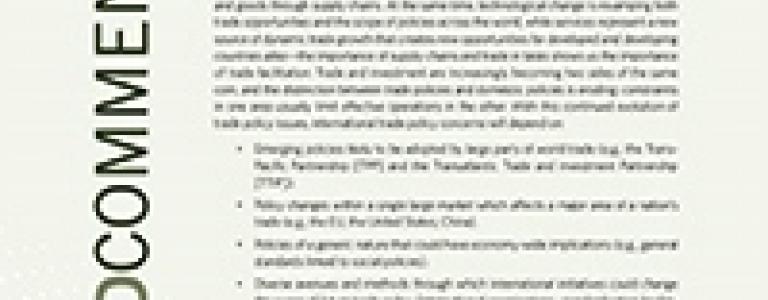Future Contours of International Trade Policy
In this commentary, Harsha Vardhana Singh argues that trade and investment are increasingly becoming two sides of the same coin, and the distinction between trade policies and domestic policies is eroding.
Policy-makers and the business community will have to develop systems for rapid assessment of impact of change and quick response. Since multiple policy issues may arise within a short period of time, mechanisms will be needed for clear prioritization of policy steps.
According to Singh, trade policy will keep evolving. Thus, in planning the future contours of their trade policy, there is a need—especially for large emerging economies—to develop a strategy for transition towards the kinds of regulatory standards and disciplines that reflect the future, such as those encompassed in the policy regimes of the OECD countries. Flexibility and quick response would become a key element of competitiveness. A system of benchmarking with others would serve as a guidepost for both the direction and the extent of progress.
In addition, nations will have to evolve ways to deal with the extensive use of private standards and the growing role of the private sector as an alternative determinant of trade policy through voluntary policies. Together with new developments in technology and social media, these factors make it difficult to govern or manage trade policy initiatives. They imply that governments need to develop or work with commonly agreed platforms or systems to enhance transparency and predictability. A key component of such an initiative has to be a systematic application of good governance principles, so as to encourage exchanging information, developing criteria for better harmonization or mutual recognition of standards, and addressing difficulties or disputes through reliable and acceptable mechanisms.
You might also be interested in
CSDDD: EU's Due diligence law vote should drive supply chain sustainability efforts
The European Parliament has voted to adopt the Corporate Sustainability Due Diligence Directive, aiming to address the environmental and social impacts of the supply chains of Europe's large corporations.
Will the Inclusion of Voluntary Standards in Trade Agreements Lead to More Sustainable Trade?
The use of voluntary sustainability standards (VSSs) and similar systems in free trade agreements (FTAs) is gaining traction. Will it lead to more sustainable production and consumption globally?
Ecuador Referendum Rules Out ISDS Return, Underlining Public Support for a Sustainable Path
Ecuador has voted to allow international arbitration and investor–state dispute settlement (ISDS) in its treaties and agreements. But the risks that initially made them turn away from this outdated model remain.
A Sustainable Asset Valuation Assessment of Building and Transport Infrastructure Investment in the Shymkent-Tashkent-Khujand Economic Corridor
This report presents the Sustainable Asset Valuation (SAVi) of a proposed transport and building infrastructure development on the border of Kazakhstan and Uzbekistan to promote close and mutually beneficial trade relationships between the countries.
